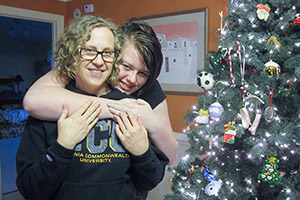The shooting at Sandy Hook Elementary School in Newtown, Conn., one year ago sparked a national conversation about the country’s troubled mental health system. Politicians convened task forces and promised additional funding and new laws. But despite those promises, one year later, patients and advocates say treatment for mental health is still in shambles.
Rheanna Kathleen Morris, 18, was diagnosed with bipolar II at the end of her sophomore year of high school and has spent the past two years in and out of psychiatric units and residential treatment facilities near her home in the suburbs of Richmond, Virginia.
Her mother Peggy Sinclair-Morris is a former special education teacher with a network of helpful contacts. But even for this family with the know-how to work the system, it’s been a constant challenge.
“It’s scary. It’s very fragmented.” says Sinclair-Morris. “There’s not a one-stop shop. You have to call people. You have to network. You have to find someone who might have had experiences similar to yours. “
From the family’s perspective, not much has changed in the year since the shooting at Sandy Hook, and recent events in Virginia seem to support that conclusion. Just last month, State Senator Creigh Deeds’ 24-year-old son stabbed his father several times before killing himself. Austin Deeds had struggled with serious mental health problems and was denied a bed in a psychiatric facility the day before.
The rate of violent crimes among the mentally ill is very low, but Rheanna says the story hit home anyway.
“I almost cried, actually. I was reading about it in a newspaper, and I thought, ‘What if that had been me?’” she says. “I know I would never hurt my family, but if it had been me, you wouldn’t hear about it all over the news, you know. Nothing would have happened.”
The last time Rheanna was hospitalized, she waited in the emergency room for eight hours before a bed was found in a psychiatric ward. Both Rheanna and her mother worry that next time, they might not be as lucky.
“I mean Deeds is well known in the state, very well liked and he couldn’t get services,” said Sinclair-Morris. “So for your average Joe, what does that mean exactly?”
Virginia talked about its mental health system after Sandy Hook and ended up boosting funding by about 5 percent. A similar conversation was going on in states across the country. In 2013, a total of 36 states increased funding for mental health. But that was a drop in the bucket after four years of steep cuts during the recession that had brought the system to the brink of collapse, says Sita Diehl, state policy director at the National Alliance on Mental Illness.
“After these sorts of shootings, there’s a lot of talk, and a lot of policy-makers saying we need to do something about the mental health system. But then when push comes to shove and the budget debates occur, mental health seems to lose out,” Diehl says.
Most of the additional funding appeared in state bills that were already being considered, she adds. The events in Newtown just gave legislators the push they needed to pass them. Still, that’s a lot more than was done by federal legislators.
“I give the states a B plus,” says DiehI. “I give the feds a C- maybe a D: lots of talk, no action.”
Despite all of the dialogue and consternation, Congress didn’t pass mental health legislation following Sandy Hook. Instead, it tied possible changes to the gun control act, which never passed the Senate. Several bills are still in the works.
On the other hand, Diehl says the Obama administration did quite well by recently publishing the long overdue set of mental health parity rules. The administration has also been pushing states to expand their Medicaid programs under the Affordable Care Act, which would infuse new money into the system. So far, Virginia has declined to expand Medicaid.
But overall, says Diehl, the national response to Sandy Hook was disappointing. That doesn’t come as a shock to Virginians, says Mira Signer, who runs NAMI’s Virginia’s chapter. In 2007, the state was the site of the deadliest mass shooting in U.S. history on the campus of Virginia Tech. The attack left 33 people dead at the hands of a man with a serious mental illness.
During the legislative session immediately following the shooting, the state added $42 million in new mental health funding. But then the recession hit, and they cut about $38 million from mental health, “so we were kind of back to square one,” says Signer.
Then this week, following the Creigh Deeds tragedy, Governor Robert McDonnell, R-Virginia, pledged to add $38 million back in the system. Signer says this this sort of roller coaster in funding is typical in mental health, but it’s no way to run a system because in the end, little changes.
“I can look at reports and studies that were done like 10, 15, or 20 years ago, and I’m looking at the recommendations, and they’re still true today. You just have to slap another date on it,” says Signer. “Because they all say the same thing,”
Cutting mental health funding, she adds, is foolish because “mental health [expenses] will show up in other systems—it shows up in the criminal justice system, it shows up in homelessness, it shows up in high emergency room usage,” Signer says. “It’s an illusion to cut it.”








